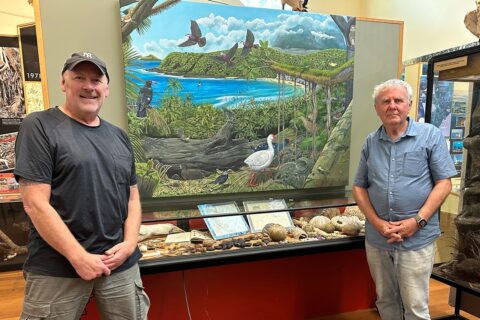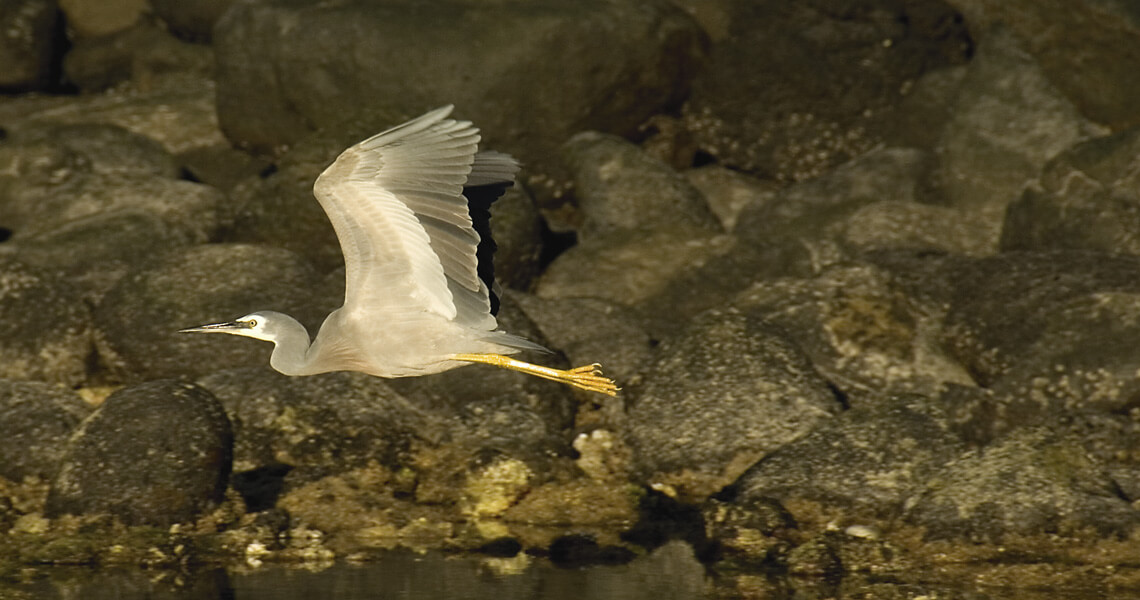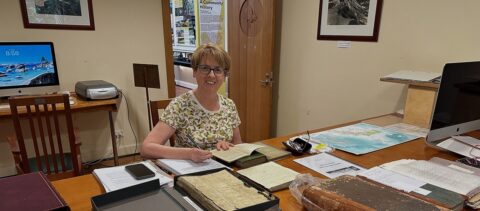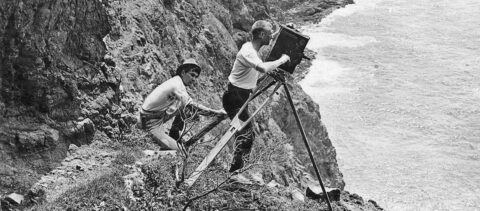
Artist Julian Hume installs new mural
Artist and palaeontologist Julian Hume visited the Museum and installed a canvas mural in the environmental gallery.

Birds have the greatest mobility of all terrestrial creatures and form the principal fauna of small oceanic islands, including Lord Howe, which has substantial breeding populations of land and seabirds. Two hundred and thirty-eight species of birds have been recorded on Lord Howe Island, of which 31 are regular breeders today — 14 species of seabirds, and 17 species of landbirds. There are also a number of regular visitors that return at the same time each year on migratory paths.
This abundance of bird life was a significant factor in recognising the island for World Heritage listing in 1982.
Surrounded by ocean for hundreds of kilometres, Lord Howe Island is a haven for breeding seabirds. Fourteen different species breed each year, in numbers of hundreds of thousands.
Lord Howe Island has some notable features about its seabird populations. It is the only breeding location in the world for the Providence petrel (apart from a few pairs recently discovered on the offshore islands of Norfolk Island); the only breeding location in Australia for the Kermadec petrel and Grey ternlet; the most southerly breeding location in the world for the Sooty tern, Common Noddy, Black noddy and Masked booby; the world’s largest concentration of Red-tailed tropicbirds breeding, and the only breeding population of Flesh-footed shearwaters off Eastern Australia.
In addition to those birds that breed on the Island, several other species are regular visitors and can be seen on the Island in small numbers each year. These are species of migratory shorebirds that breed in the northern hemisphere around the Arctic Circle and Alaska, and then spend their winter in the southern hemisphere on areas of shoreline on continents and islands.
They include the Eastern Golden Plover, Whimbrel, Ruddy Turnstones, Bar-tailed Godwit, Red-necked stint, Wandering and Grey-tailed tattler. A regular winter visitor is the Double-banded plover from New Zealand.
A total of 201 species of birds have been recorded on Lord Howe Island, some of these only once, as rare vagrants.
When discovered, Lord Howe Island had fifteen species of Landbird, of which thirteen were endemic forms. Nine of the original fifteen are now extinct. All these birds had evolved and existed on the Island for many thousands of years without natural predators. But when man came in search of food, and with his domestic animals, they knew no fear and many species were soon exterminated. Two were literally eaten into extinction — the White gallinule (Notornis alba) and the White-throated pigeon (Columba vitensis), while a third, the Red-crowned Parrakeet (Cyanoramphus novaezelandiae subflavescens) was eliminated because it was a pest that damaged fruit and grain crops; all three were extinct by the 1860s.
The LHI Currawong, the LHI Golden Whistler, the LHI White-eye, the Emerald Ground dove, and Sacred kingfisher were able to survive the predation by introduced animals.
Since settlement, twelve other species of birds have become established on Lord Howe Island, whether by introduction (the Buff Banded Rail, Masked owl, Barn owl, Peewee, Blackbird and Song Thrush) or by natural colonisation (White-faced heron, Nankeen kestrel, Welcome swallow, European Starling, Purple Swamphen and the Masked Lapwing).
The last two species to colonise the Island arrived in 1985 and 1990. All of these landbirds that have colonised since settlement probably depend for their survival on the modifications to the environment made by humans – clearing of lowland forest for pasture and housing.
The most celebrated of the landbirds of Lord Howe Island is the Woodhen, Tricholimnas sylvestris, a flightless bird from the rail family, most closely related to the Weka of New Zealand. It is similar in size to a bantam, stands 30cm high and weighs 400-550 grams. The body plumage is olive-brown in colour, although older birds sometimes develop white ear coverts. The wing feathers are chestnut coloured with black bars visible only when the bird spreads its wings. The bill is slightly down-curved, about 50mm long and pinkish-grey in colour.
Woodhens are very inquisitive and will emerge from thick undergrowth to investigate the source of any unusual noise. This habit made them easy prey for hungry sailors who came ashore for food before settlement in 1834. Then the early settlers hunted them for food, plus brought cats, dogs and pigs that also hunted them. By the 1880s the Woodhen was confined to the mountain summits. The Woodhens managed to survive there in low numbers until scientists from the Australian Museum took interest in the 1970s and planned a successful recovery program carried out in the 1980s. The recovery program involved removing feral cats, dogs and pigs from the Island. From a mere 30 birds in 1970, there are now approximately 440 Woodhens living across the Island.
The Museum’s Biodiversity Index contains listings for many of the common birds found on Lord Howe Island. Use the filters below, to learn more.


Artist and palaeontologist Julian Hume visited the Museum and installed a canvas mural in the environmental gallery.

Visiting researcher Susan Johnson provided provided some insight into the island’s history.

Philip Payten was a NSW surveyor who moved to Lord Howe Island in 1923, and helped form the local Lawn Bowls Club.

30th August 2025 marked the centennary of the death of naturalist Alan McCulloch